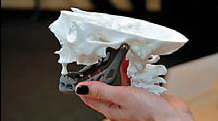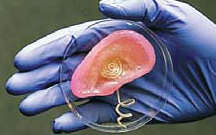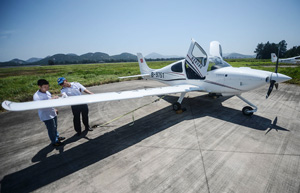


In 2002 CT and MRI data was used to 3-D print anatomical models of conjoined twins from Egypt in the United States, to plan for the separation surgery. The surgery succeeded in 2003, and the twins lived six years.
In 2011, researchers in Belgium and the Netherlands created and implanted an entire 3-D printed lower jaw (pictured above) for an 83-year-old woman. It was the world's first complete 3-D printed implant.
In 2012, specialists in the US created an airway device with a 3-D laser printer with approval from the US Food and Drug Administration, and saved a baby boy, whose birth defect had caused his throat's airway to collapse frequently.
In February 2013, scientists at Cornell University announced it had used 3-D printing to create an artificial ear for treating ear deformity.
In March, US doctors used 3-D printed artificial skull bones, and replaced 75 percent of a patients' skullcap that had been severely damaged, with approval from the FDA.
In April, scientists in the US managed to create mini versions of liver using a 3-D printer. They built up layers of liver cells, including cells from the lining of blood vessels to nourish the liver cells with nutrients and oxygen.

In May, scientists at Princeton University announced they had printed a working human ear (pictured) with electric and organic materials, including cow cells. The replica ear can hear beyond human ability.
China Daily
(China Daily 08/14/2013 page19)
 Lingering droughts affect 16.7m people in SW China
Lingering droughts affect 16.7m people in SW China
 Huawei unveil Ascend P6 smartphone in Vienna
Huawei unveil Ascend P6 smartphone in Vienna
 Rocky villa built on top of building in Beijing
Rocky villa built on top of building in Beijing
 Construction of SW China's Shilin tunnel underway
Construction of SW China's Shilin tunnel underway
 Zhejiang has first school for private pilots
Zhejiang has first school for private pilots
 Sexy models in CFGP race
Sexy models in CFGP race
 Trip to Hong Kong Ocean Park
Trip to Hong Kong Ocean Park
 Model with modified Chevy Camaro
Model with modified Chevy Camaro